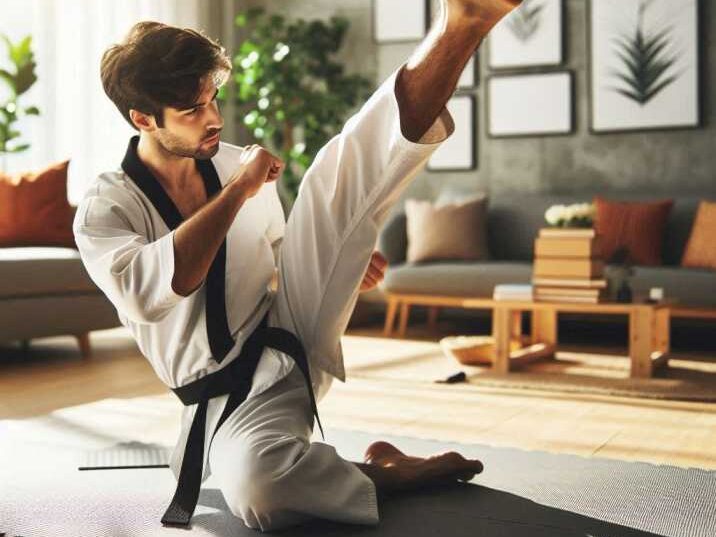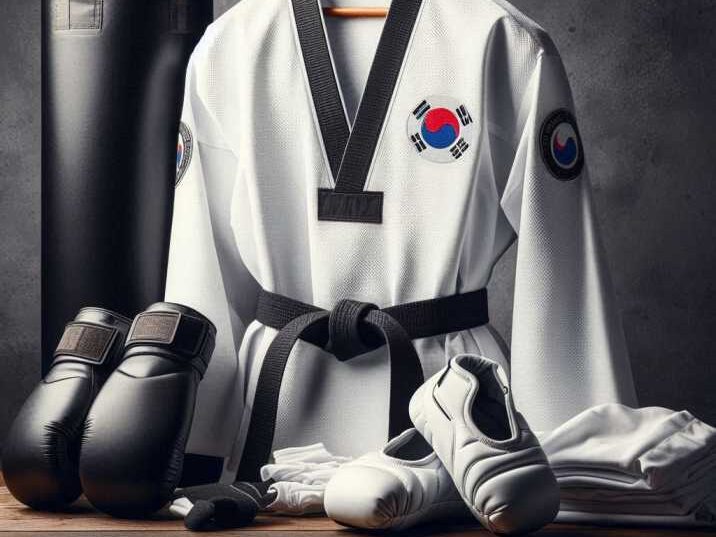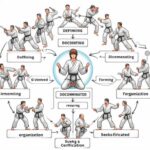Introduction
Table of Contents
Taekwondo is a dynamic and exciting martial art that combines powerful kicks, precise hand strikes, and graceful movements. It originated in Korea and has become popular worldwide, including in the USA. Many people are eager to start Taekwondo but wonder if it’s possible to learn taekwondo at home. In this article, we’ll explore whether you can effectively practice Taekwondo on your own, what you need to get started, and tips for safe and successful home training.

What is Taekwondo?
Taekwondo is a Korean martial art known for its emphasis on high, fast kicks and jumping and spinning kicks. It also includes hand techniques and forms, known as “poomsae,” that develop coordination, strength, and agility. Taekwondo is not only a means of self-defense but also a sport and a way to enhance physical fitness and mental discipline.
Key Components of Taekwondo
Kicks
Kicks are one of the most distinctive features of Taekwondo. They are known for their speed, power, and height. Taekwondo practitioners use a variety of kicks to strike their opponents or practice their techniques. Some common types of kicks include:
- Front Kick (Ap Chagi): A quick, straight kick aimed at the opponent’s midsection or head.
- Roundhouse Kick (Dollyo Chagi): A circular kick that strikes the target with the instep or ball of the foot, often used to target the side of the opponent’s body.
- Side Kick (Yop Chagi): A powerful kick where the practitioner extends their leg sideways to strike with the edge of the foot.
- Back Kick (Dwi Chagi): A kick executed by turning the back to the opponent and kicking backward with the heel.
These kicks help develop flexibility, strength, and coordination, and are central to Taekwondo’s fighting techniques.
Hand Techniques
Hand Techniques in Taekwondo complement the kicking techniques and are essential for both offense and defense. They include:
- Punches (Jireugi): Direct strikes with the fists, such as the straight punch (Ap Jireugi) and the reverse punch (Bandae Jireugi).
- Blocks (Makki): Defensive movements used to intercept or deflect an opponent’s attacks. Common blocks include the low block (Arae Makki) and the high block (Olgul Makki).
- Strikes (Chigi): Various striking techniques using different parts of the hand, like the knife-hand strike (Sonkal Chigi) and the hammerfist strike (Jirugi).
These techniques enhance hand-eye coordination, strengthen the upper body, and improve overall combat effectiveness.
Forms (Poomsae)
Forms, or Poomsae, are choreographed patterns of movement that simulate combat scenarios against imaginary opponents. Practicing poomsae helps students develop:
- Techniques: Integrating various kicks, punches, and blocks into a fluid sequence.
- Balance and Coordination: Performing precise movements while maintaining stability.
- Focus and Discipline: Following the specific sequence of movements with concentration.
Forms are a key aspect of Taekwondo training, allowing practitioners to practice techniques in a structured manner.
Sparring
Sparring (or Dae Ryun) involves controlled fighting with a partner. It is a practical application of techniques learned during training. There are two main types of sparring:
- Point Sparring: A competitive format where points are scored for controlled, accurate strikes to specific areas of the opponent’s body.
- Full-Contact Sparring: A more intense form where practitioners engage in continuous fighting with full contact, often used to prepare for real-life scenarios.
Sparring helps develop timing, distance management, and the ability to adapt techniques in a dynamic environment.
Breaking
Breaking (or Kyuk Pa) involves using Taekwondo techniques to break boards or other materials. This practice demonstrates:
- Strength: The ability to generate force to break objects.
- Precision: Accurate technique to ensure the strike lands effectively.
- Confidence: Building self-assurance in the practitioner’s abilities.
Common breaking techniques include using various kicks and strikes to break wooden boards. Breaking is often used as a test of technique and power.
Is It Possible to Learn Taekwondo at Home?
Learning Taekwondo at home can be a practical option for many, but it comes with its own set of advantages and challenges. Here’s a detailed look at both sides to help you decide if this approach is right for you.
Pros of Learning Taekwondo at Home
- FlexibilityFlexibility is one of the biggest advantages of practicing Taekwondo at home. You have the freedom to train whenever it fits your schedule, whether that’s early in the morning or late at night. This flexibility allows you to practice at your own pace, revisit techniques as needed, and integrate training into your daily routine without the constraints of scheduled class times.
- CostCost savings can be significant when training at home. You eliminate expenses such as gym memberships, travel costs to a Taekwondo school, and other fees associated with formal classes. This makes it a more budget-friendly option for those who might not be able to afford regular lessons.
- ConvenienceConvenience is another advantage. Training at home means you don’t have to commute to a dojo or gym. You can practice in the comfort of your own space, which is especially beneficial if you have a busy lifestyle or prefer a private training environment. Additionally, you can set up your practice area exactly how you like it, with all the equipment you need readily accessible.
Cons of Learning Taekwondo at Home
- Lack of SupervisionLack of Supervision is a significant drawback. Without a trained instructor present, you may not receive the immediate feedback and corrections needed to perfect your techniques. This absence of supervision can lead to improper form or technique, which might hinder your progress and increase the risk of developing bad habits.
- Safety RisksSafety Risks are another concern. Training alone increases the likelihood of injury, especially when practicing complex kicks or techniques without proper guidance. Without an instructor to oversee your practice and ensure you’re using the correct form, you might inadvertently hurt yourself. It’s crucial to take necessary precautions and practice safety measures to minimize these risks.
- Limited ProgressLimited Progress can occur without regular feedback and guidance. Learning advanced techniques, mastering forms (poomsae), and refining your skills are challenging to achieve without an experienced instructor. Progress might be slower as you may not have access to expert advice and corrections that are essential for improving and advancing in Taekwondo.
What You Need to Get Started
If you decide to learn Taekwondo at home, here’s what you’ll need:
Essential Equipment
- Taekwondo Uniform (Dobok) The Taekwondo Uniform or Dobok is traditional clothing worn during practice. It consists of a jacket, pants, and a belt that signifies rank. Wearing a Dobok helps you get into the right mindset for training and ensures you are practicing in attire that supports your movements.
- Training Mat A Training Mat provides a safe surface for practicing kicks, falls, and other movements. It helps prevent injuries by cushioning impacts and providing traction. A good mat is essential for practicing at home to ensure you have a safe and suitable environment for your workouts.
- Training Equipment
- Punching Bag: Useful for practicing strikes and improving power and technique.
- Focus Mitts: These can be used for precision training and to simulate a partner’s target areas.
- Boards for Breaking Practice: Used to practice breaking techniques, demonstrating strength and accuracy.

Resources
- Instructional VideosInstructional Videos are a valuable resource for home training. Many reputable Taekwondo schools and instructors offer online tutorials that cover techniques, forms, and drills. These videos can provide visual demonstrations and explanations, helping you learn and practice effectively.
- BooksBooks on Taekwondo techniques and forms can serve as a helpful reference. They provide detailed descriptions and illustrations of various techniques, forms, and training methods. Books are a great way to supplement your learning and gain a deeper understanding of Taekwondo principles.
- Online ClassesOnline Classes offer structured training with an instructor who can provide guidance and feedback remotely. Virtual classes can help you stay on track with your training, receive personalized instruction, and interact with other students. This option combines the benefits of home training with the oversight of an experienced instructor.
Tips for Learning Taekwondo at Home
1. Start with the Basics
Focus on foundational techniques such as basic kicks, stances, and hand techniques. Understanding these fundamentals will set the stage for more advanced training.
2. Use Online Resources
Leverage instructional videos and online classes. Websites like YouTube have numerous tutorials, but ensure they come from credible sources.
3. Create a Training Schedule
Set aside regular times for practice to develop discipline and consistency. A structured schedule helps track progress and maintain motivation.
4. Practice Safety First
Warm up before each session to prevent injuries. Use appropriate safety gear and create a safe training environment to avoid accidents.
5. Set Realistic Goals
Break down your training into manageable goals. This can include mastering a specific technique, improving flexibility, or achieving a new belt rank.
6. Track Your Progress
Keep a training journal to monitor improvements and areas needing attention. This helps in staying focused and motivated.
7. Seek Feedback
Even if training at home, consider occasionally visiting a local Taekwondo school for feedback and to ensure you are on the right track.
Table of Information about Learn Taekwondo at Home
| Aspect | Details |
|---|---|
| Origin | Korea |
| Focus | High kicks, hand techniques, forms, sparring, breaking |
| Benefits | Physical fitness, self-defense, mental discipline |
| Equipment | Uniform, training mat, punching bag, focus mitts, boards |
| Learning Resources | Instructional videos, books, online classes |
Conclusion
While learning Taekwondo at home is possible, it requires dedication, discipline, and the right resources. By starting with the basics, using online resources, and practicing safety, you can make significant progress in Taekwondo. However, for comprehensive learning and to achieve advanced techniques, training under the guidance of a skilled instructor is highly recommended. Embrace the journey of learning Taekwondo and enjoy the benefits of this powerful martial art.
FAQs
1. Can I learn Taekwondo without a teacher?
Yes, but it’s challenging. Self-learning can be effective for basics, but advanced techniques and safety are best taught by a qualified instructor.
2. What is the best way to find online Taekwondo classes?
Look for classes from reputable Taekwondo schools or instructors. Check reviews and testimonials to ensure quality.
3. Do I need special equipment to practice Taekwondo at home?
Essential equipment includes a Taekwondo uniform, training mat, and possibly a punching bag. Safety gear is also recommended.
4. How often should I practice Taekwondo at home?
Aim for regular practice, ideally 3-4 times a week, to maintain progress and improve skills.
5. Can I achieve a black belt by learning Taekwondo at home?
While home practice can help you progress, achieving a black belt typically requires training with an instructor and passing formal tests.


